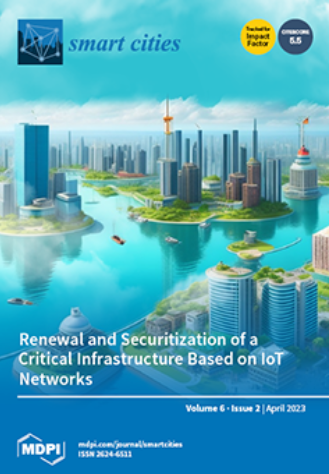The Exclusiveness of Smart Cities—Myth or Reality? Comparative Analysis of Selected Economic and Demographic Conditions of Polish Cities
IF 5.5
Q1 ENGINEERING, ELECTRICAL & ELECTRONIC
引用次数: 0
Abstract
The Smart City concept is perceived as a method of dynamic development of cities and an opportunity to improve the quality of life of the urban community. Nevertheless, it is not without its disadvantages, among which the possibility of exclusion (economic, social or digital) is most often mentioned. However, the literature on the subject lacks empirical research verifying this allegation. For this reason, the purpose of this article is to conduct a comparative analysis of economic and social conditions in 17 Polish cities, 3 of which are recognized as Smart Cities in international rankings. By analyzing the economic and demographic conditions in the long term, an attempt is made to answer the question of whether Smart Cities offer better living conditions, and if so, how big is the imbalance and the risk of excluding other cities? In the course of the research, the following are taken into account: tax revenue per capita, unemployment rate, population density and level, as well as the share of working and post-working age population. These parameters are analyzed using descriptive statistics and systematized using multi-criteria analysis. The collective comparison of all the surveyed provincial cities shows that the best economic and demographic conditions apply to cities recognized as smart. The average annual rate of changes in tax revenues in the surveyed cities ranges from 5% to almost 8% and is the highest in Warsaw, Kraków and Wrocław. These cities are also characterized by the lowest unemployment rate, ranging from 3% to 4% (in other cities, from 4% to almost 7%). The mentioned cities and Gdańsk are the only ones with a positive rate of population change (from 0.62% to 1.08%). Other studied cities are systematically depopulating (annual rate of change from −0.37% to −7.09%). In Warsaw, Wrocław and Kraków, the share of the working-age population is also decreasing the slowest (the annual rate of change below −1.0%). The cities recognized as smart (Warsaw, Kraków and Wrocław) are matched by Gdańsk and Poznań, which can be considered strong contenders for being smart. Unfortunately, the remaining cities are far from the leaders of the ranking, which may expose them to economic and social exclusion, all the more so that the parameters examined in them are characterized by negative tendencies. It can, therefore, be concluded that striving to be smart can be a cause of increasing the economic and demographic distance. Therefore, it may increase unbalance and generate exclusion in the analyzed areas.智慧城市的排他性——神话还是现实?波兰选定城市经济和人口状况的比较分析
智慧城市概念被认为是城市动态发展的一种方法,也是提高城市社区生活质量的一个机会。然而,它并非没有缺点,其中最常提到的是(经济、社会或数字)排斥的可能性。然而,关于这一主题的文献缺乏验证这一指控的实证研究。因此,本文的目的是对17个波兰城市的经济和社会状况进行比较分析,其中3个城市在国际排名中被公认为智慧城市。通过分析长期的经济和人口状况,试图回答智慧城市是否提供更好的生活条件,如果是,这种不平衡和排除其他城市的风险有多大?在研究过程中,考虑了以下因素:人均税收,失业率,人口密度和水平,工作和后工作年龄人口的比例。使用描述性统计对这些参数进行分析,并使用多标准分析将其系统化。所有被调查的省级城市的集体比较表明,最佳的经济和人口条件适用于被公认为智慧的城市。在被调查的城市中,税收收入的平均年变化率从5%到近8%不等,其中华沙、Kraków和Wrocław最高。这些城市的失业率也最低,在3%到4%之间(在其他城市,从4%到近7%)。上述城市和Gdańsk是仅有的人口变化率为正的城市(从0.62%到1.08%)。其他研究的城市正在系统地减少人口(年变化率从- 0.37%到- 7.09%)。在华沙,Wrocław和Kraków,适龄工作人口的比例下降速度也最慢(年变化率低于- 1.0%)。华沙、Kraków和Wrocław被认为是智慧城市,其次是Gdańsk和波兹纳瓦,这两个城市被认为是智慧城市的有力竞争者。不幸的是,其余的城市离排名的领先者很远,这可能使它们面临经济和社会排斥,因此它们所检查的参数的特点是消极的趋势。因此,可以得出结论,努力变得聪明可能是增加经济和人口距离的一个原因。因此,它可能会增加分析区域的不平衡并产生排斥。
本文章由计算机程序翻译,如有差异,请以英文原文为准。
求助全文
约1分钟内获得全文
求助全文
来源期刊

Smart Cities
Multiple-
CiteScore
11.20
自引率
6.20%
发文量
0
审稿时长
11 weeks
期刊介绍:
Smart Cities (ISSN 2624-6511) provides an advanced forum for the dissemination of information on the science and technology of smart cities, publishing reviews, regular research papers (articles) and communications in all areas of research concerning smart cities. Our aim is to encourage scientists to publish their experimental and theoretical results in as much detail as possible, with no restriction on the maximum length of the papers published so that all experimental results can be reproduced.
 求助内容:
求助内容: 应助结果提醒方式:
应助结果提醒方式:


